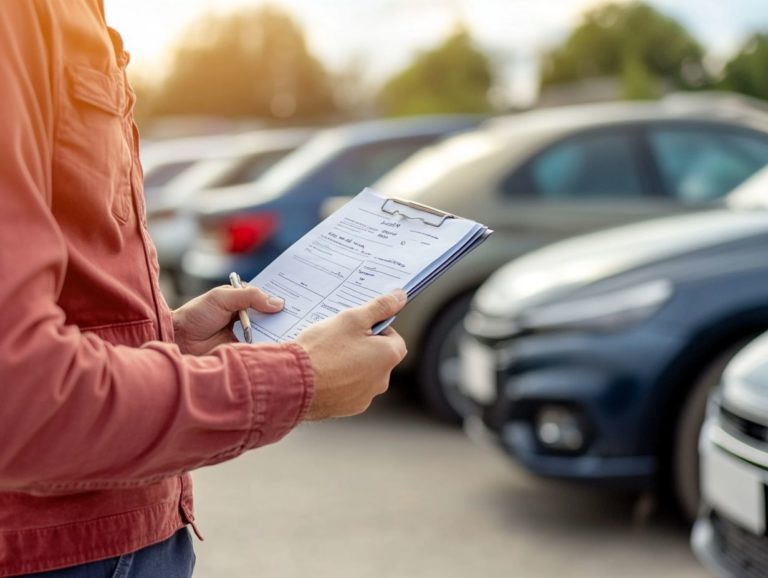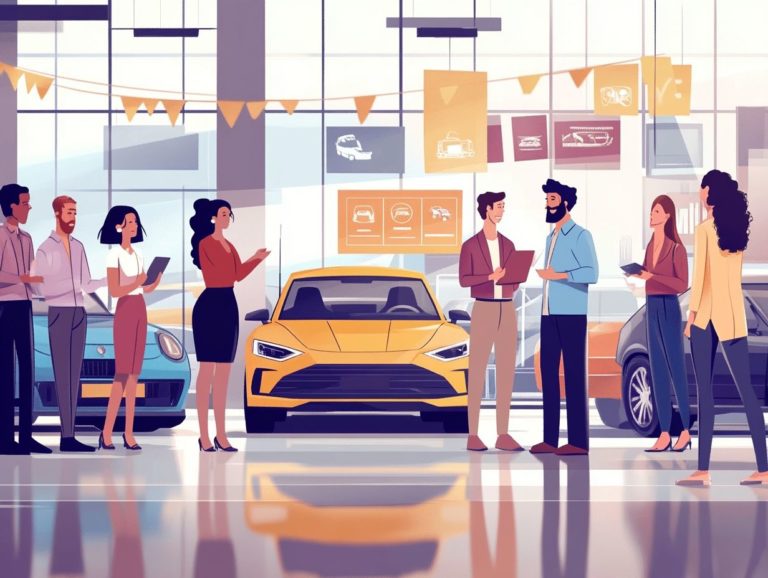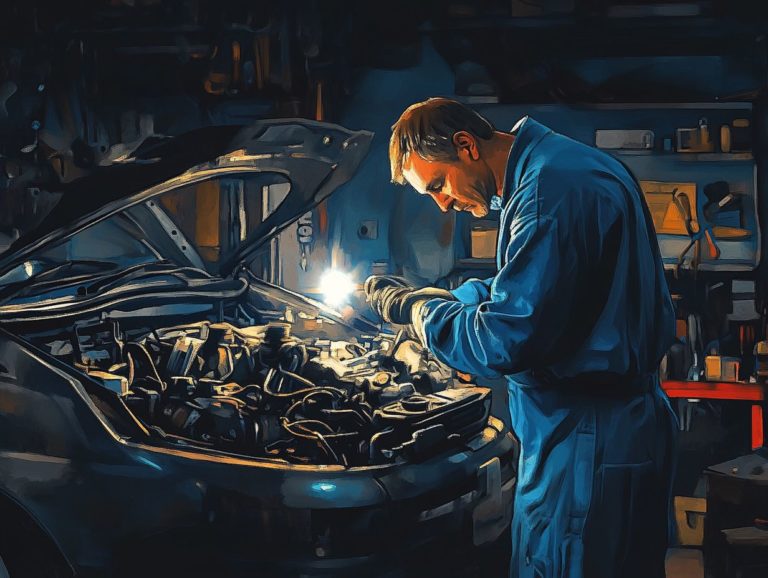What to Look for in a Used Car Test Drive
When you re in the market for a used car, a test drive isn t merely a leisurely loop around the block; it s an essential part of making a wise investment.
This article explores the many benefits of test driving a used vehicle, from assessing its performance to determining your comfort level behind the wheel. It offers insights on how to prepare effectively, what to pay attention to during the drive, and how to use your experience to negotiate better terms.
Whether you re a first-time buyer or a seasoned car enthusiast, this guide will empower you to navigate the test drive process with confidence.
Contents
- Key Takeaways:
- Why a Test Drive is Important
- Preparing for the Test Drive
- During the Test Drive
- After the Test Drive
- Tips for Negotiating After a Test Drive
- Frequently Asked Questions
- What should I look for during a used car test drive?
- How can I ensure the car is in good condition during a test drive?
- What are some red flags to look for during a test drive?
- What should I ask the seller or dealership during a used car test drive?
- Is it necessary to test drive a used car before buying?
- What should I do after the test drive if I’m interested in purchasing the car?
Key Takeaways:

- Test driving a used car is crucial for determining its condition and ensuring a good purchase.
- Research the car and seller before the drive, and bring necessary documents.
- During the test drive, focus on key areas and ask the seller questions.
Why a Test Drive is Important
A test drive is an essential part of your car-buying journey. It gives you the opportunity to experience firsthand how a used car performs on the road. This hands-on experience is your ticket to uncovering hidden gems or potential pitfalls! It is crucial for evaluating the vehicle’s comfort, handling, and overall performance, allowing you to uncover any hidden issues that might escape notice during a standard inspection.
Understanding the vehicle’s history is vital. Reviewing repair estimates can significantly inform your decision-making process, ensuring that you make one of the most substantial investments of your life with confidence. With a comprehensive Buyer’s Guide in hand, your test driving experience can transform into an enlightening adventure.
Benefits of Test Driving a Used Car
Test driving a used car presents you with a wealth of benefits. It allows you to assess its condition and performance before committing to a purchase.
Taking the vehicle for a spin enables you to thoroughly inspect essential features that can significantly influence your long-term satisfaction. As you drive, look for any oil leaks (fluid escaping from the engine) that might signal engine issues. Evaluate the state of balding tires that could lead to expensive replacements. Listen intently to the engine’s sound to detect any irregularities.
This firsthand experience not only deepens your understanding of the vehicle’s mechanics but also offers valuable insights into how it handles on the road. Ultimately, it enables you to make a well-informed and confident buying decision.
Preparing for the Test Drive
Preparing for a test drive is essential. It ensures you make the most informed decision when purchasing a car. This process requires thorough research on both the vehicle and the seller. It allows you to approach the experience with confidence and clarity.
Researching the Car and Seller
Researching both the car and the seller is a crucial step in the test-driving journey. It arms you with essential insights into the vehicle’s history and the seller’s credibility.
Utilizing resources like Carfax for comprehensive vehicle history reports can unveil invaluable details, such as previous accidents, changes in ownership, and any documented service history. By exploring this information, you can make well-informed decisions and potentially sidestep future complications.
Checking the seller’s credentials, including references from affiliated repair shops, adds an extra layer of reassurance. This allows you to assess the seller’s trustworthiness and reputation more effectively. A thorough investigation not only boosts your confidence but also ensures that your investment is sound, setting the stage for a more rewarding purchase experience.
So gear up for that test drive! The right car is waiting for you, and every moment counts!
What to Bring and Wear

When preparing for a test drive, it’s essential to gather the necessary items and wear comfortable clothing. This facilitates a comprehensive evaluation of the vehicle.
Having a notepad at your side can prove invaluable for jotting down observations. A checklist ensures you don’t overlook key aspects such as handling, visibility, and comfort during your assessment.
Selecting the right attire is equally important. Lightweight, breathable clothing promotes free movement, while comfortable shoes enhance your overall driving experience.
This thoughtful combination boosts your comfort and allows you to concentrate fully on the car’s performance. This enables a clearer assessment of how well it aligns with your needs.
During the Test Drive
During your test drive, it’s essential to engage actively with the vehicle’s performance. Evaluate how the vehicle handles different driving conditions and maneuvers try out U-turns, test its response at both low and high speeds, and pay attention to whether the car tends to pull to one side.
This hands-on evaluation is crucial in determining if the vehicle meets your driving preferences and needs.
Key Areas to Pay Attention to
During a test drive, focus on key elements like the sound of the engine, the responsiveness of the brakes, and how well the moving parts function.
As you drive, listen carefully for any unusual engine noises that could hint at underlying issues. Smooth operation is critical for reliability.
When testing the brakes, pay attention to how quickly and effectively they engage. Effective brakes are crucial for safe driving; any hesitation or grinding sounds might indicate potential problems.
You should also observe the vehicle’s overall handling, noting the feel of the steering wheel and any vibrations. These can suggest alignment or suspension issues.
Additionally, take note of how well the car accelerates and decelerates. This will provide valuable insights into its performance and overall condition.
Questions to Ask the Seller
Asking the right questions during a test drive can unveil invaluable insights into the vehicle s condition and history. Don’t miss the chance to uncover valuable insights about your potential new ride!
It s essential to dig deeper and discover the true story of the car you re considering. Inquire about the repair history ask if the vehicle has been involved in any major accidents or if significant components have been replaced.
Understanding how the seller has managed previous maintenance can provide critical clues about the car s overall upkeep. Don t hesitate to probe into any known hidden issues, like persistent engine noises or electrical quirks.
This kind of dialogue not only sheds light on the car s current state but also builds trust, enabling you to make a more informed purchasing decision.
After the Test Drive
Upon finishing the test drive, take a moment to critically assess your experience. Consider every detail of the vehicle and delve into its history to enrich your decision-making process.
Evaluate your experience to make a better choice that aligns with your needs and expectations.
Evaluating the Experience and Next Steps

Evaluating your test drive experience means comparing your notes and observations with your expectations and requirements. This thoughtful process helps you determine if the vehicle truly suits your needs.
Consider the standout features from your drive, such as comfort, handling, and technology, and weigh them against any potential drawbacks you ve noted. Once you’ve conducted this thorough comparison, think about your next steps.
Seeking a repair estimate can clarify any unforeseen costs. This assists you in deciding whether to proceed with purchasing the vehicle or explore other options available in the market.
Tips for Negotiating After a Test Drive
Negotiating after your test drive can greatly influence the final purchase price. By leveraging your observations and experiences from the test drive, you can effectively advocate for a more favorable deal.
Using Test Drive Results in Negotiations
In negotiations, the insights you gain from your test drive should serve as a formidable tool in your repertoire, particularly when discussing the vehicle’s condition and any required repairs.
The excitement of the drive is only part of the experience. You can also identify issues like oil leaks and worn-out tires that may affect the car’s value. When you present these concerns, come armed with specifics such as the exact location of the leaks or the precise tread depth on the tires. This strategy not only showcases your thoroughness but also strengthens your position for negotiating a lower price or requesting necessary repairs.
By clearly articulating these findings, you position yourself to make a well-informed investment while maximizing the value of your test drive experience.
Finalizing the Purchase
Once negotiations wrap up, finalizing your purchase involves making sure all the paperwork is in order, including a thorough review of the vehicle history and securing any repair estimates.
It’s essential to take a moment to meticulously double-check every document related to the transaction. This means verifying that the title is clear and understanding any potential liens on the vehicle. A lien is a legal claim against the vehicle that must be resolved before you can own it.
Assessing the vehicle’s history report can uncover critical details about previous accidents or maintenance records that could impact its value. Understanding repair estimates helps you gauge future upkeep, enabling you to make an informed decision about the overall cost of ownership.
Act quickly on these final steps to ensure a smooth transaction and enjoy peace of mind before you drive your new car home!
Frequently Asked Questions
What should I look for during a used car test drive?

During a used car test drive, it’s important to pay attention to the car’s overall performance, including acceleration, braking, steering, and handling. Additionally, for those considering electric options, it can be beneficial to know what to look for in an electric vehicle test drive. You should also listen for any strange noises and check the car’s features and functions.
How can I ensure the car is in good condition during a test drive?
To ensure the car is in good condition, check the exterior and interior for any damages or signs of wear and tear. You should also ask for maintenance and repair records and have a mechanic inspect the car before making a purchase.
What are some red flags to look for during a test drive?
Red flags to look for during a test drive include any unusual smells, noises, or vibrations, as well as engine or transmission issues. You should also be wary of any warning lights on the dashboard or any difficulty with shifting gears.
What should I ask the seller or dealership during a used car test drive?
Some important questions to ask include the car’s history, any previous accidents or repairs, and the reason for selling. You should also ask about the car’s warranty and what additional services or deals are included in the purchase.
Is it necessary to test drive a used car before buying?
Yes, it is highly recommended to test drive a used car before buying. This allows you to get a feel for the car’s performance and comfort level, as well as identify any potential issues that may not be apparent in a simple visual inspection.
What should I do after the test drive if I’m interested in purchasing the car?
If you’re interested in purchasing the car after the test drive, it’s important to negotiate the price and have a vehicle history report run. Make sure to get all agreed-upon terms in writing and have the car inspected by a mechanic before finalizing the purchase.
Ready to find your perfect used car? Use these tips to make an informed choice!






